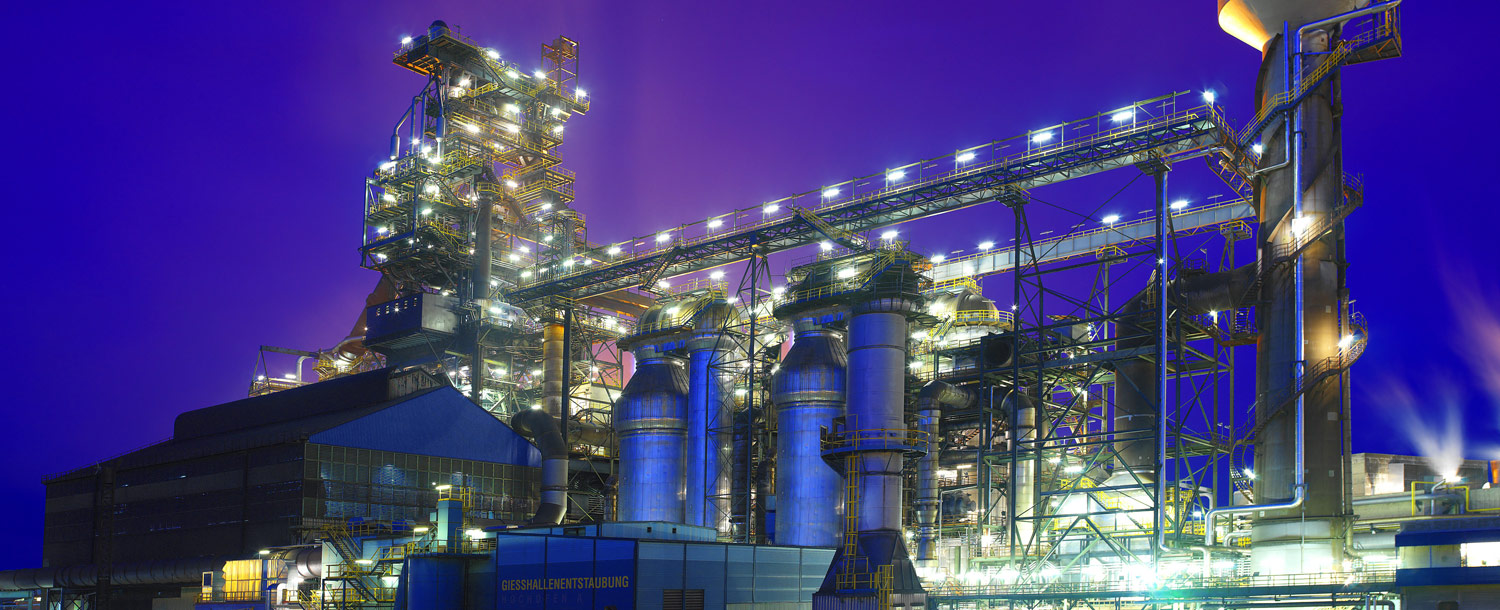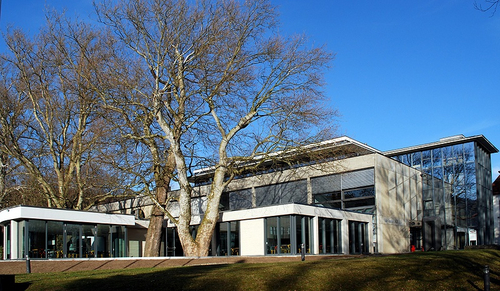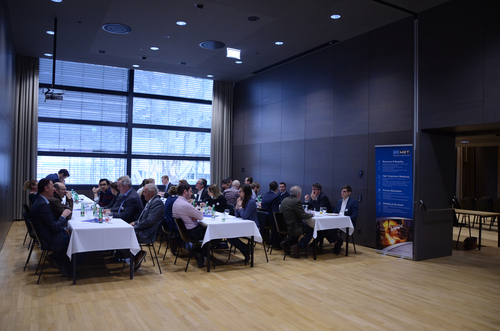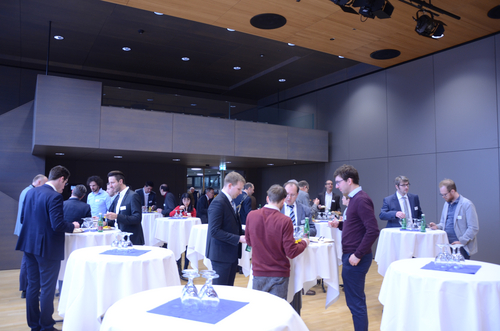The 10th Scientific Exchange Day of the K1-MET program was held on 02/07/2019 at the Johannes-Kepler-University Linz. The Scientific Exchange Day (SED) is an annual held conference, which brings together researcher and industrial partners of the K1-MET program for discussion and networking. With an overall number of nearly 100 participants this year, the event was well attended again. The morning programme consisted of presentations covering one success story for each of our four Research Areas summarizing the latest research highlights. The members of the scientific advisory board, Prof. Dr. Rüdiger Deike and Prof. Dr. Dr. h.c. Markus Reuter were the chairmen of this session.
Stefan Volker Tjaden, B. Sc. (K1-MET GmbH) presented the contribution from Research Area (RA) 1 about the progress in Project 1.2. The presentation was entitled „Towards comprehensive pulverized coal evaluation for blast furnace injection”. Pulverized coal injection is a common way to reduce the metallurgical coke consumption in blast furnaces. The aim of the current project 1.2 is the development of a standardized test protocol, which generates operational relevant results regarding coal reactivity under blast furnace similar conditions.
Florian-Markus Penz (Researcher at K1-MET) presented the success story of RA 2. His contribution with the title „The melting and dissolution behaviour of scrap in a LD converter“ was related to Project 2.2. One of the main charging materials of the Linz-Donawitz oxygen steelmaking process (LD) is scrap. Scrap acts as a coolant for the exothermic reactions inside the LD vessel and as an iron source in addition to hot metal. Within the current project, the optimization of the LD process is focused, amongst other factors, on thermodynamic and kinetic modelling. The development of a scrap melting and dissolution model with a coupled heat and mass transfer is one of the targets. A validation of results was done by experiments carried out at the Chair of Ferrous Metallurgy at Montanuniversität Leoben. Additional microprobe measurements and optical microscopy were done.
Roman Krobath (Montanuniversität Leoben) presented a contribution from RA 3, Project 3.2, which was entitled „Influencing factors and mechanisms for surface crack formation under continuous casting conditions”. In the practical aspect of continuous casting, a wide range of factors are influencing the surface cracking phenomena. There is a complex interdependency of solidification, selective oxidation, grain growth, temperature, precipitations and phase transformation on the sensitivity of a steel to form defects during the deformation. Over more than a decade, an in-situ bending experiment was developed to account for the influencing factors to crack susceptibility of steel under near process conditions. The results confirm that more information than only the surface temperature is needed to predict the crack sensitivity of a certain steel grade.
The success story from RA 4 was targeted on the modelling of metallurgical processes within the frame of Project 4.6. The presentation was entitled „Evaluation of uncertainty factors in metallurgical process operation” and was held by Andreas Spanlang (Researcher at K1-MET GmbH). Due to the nature of the processes and raw materials used, iron and steel production is subject to a wide range of uncertainty factors, which can have significant impact on the economics and reliability of operation. In order to evaluate the influence of such uncertainty factors, selected processes have been investigated using the recently introduced global system analysis (GSA) functionality of the of the gPROMS? process simulation platform. The quantification of the effect of uncertainties in process conditions, raw material compositions or prices can therefore help to minimize risks in production planning and safety as well as improve process economics.
The afternoon session of the 10th SED was filled with guest lectures and was dedicated to international cooperations. Em.O.Univ.-Prof. Dipl.-Ing. Dr.mont. Werner Kepplinger, member of the Scientific Advisory Board, was chairman of this session. The contribution of Prof. Dr. Rüdiger Deike was entitled „The importance of metallurgical processes in a future circular economy”. The global economy is in a structural change and industrial processes need to be designed according to increase resource and energy efficiency. These are characteristic features of metallurgical industries for decades, in which energy and raw material consumption is being reduced constantly. With properly designed recycling processes, it is possible to recover metals in poor dissipative distribution from oxides in metallurgical slags or filter dusts and bring them back into the materials cycles.
Circular Economy was also in the focus of the presentation held by Prof. Dr. Dr. h.c. Markus Reuter. His contribution was entitled „Challenges of the circular economy: A metallurgical perspective“. Realising the circular economy is faced with some significant challenges. Process metallurgy and its infrastructure play key roles at the heart of making the circular economy work. The enabling role of process metallurgy within the circular economy will be discussed, touching also on product and system design.
Institut Laue-Langevin from Grenoble (France) presented their portfolio. Dr. Thomas Hansen und Dr. Martin Böhm showed the competences in the field of neutron techniques. The contribution was entitled “Neutron techniques: new opportunities for microscale charaterisation in extractive metallurgy”. The Laue-Langevin Institute (ILL) is a research infrastructure that provides access to highly-specialised neutron instruments. It was shown, how neutron techniques allow the tracking of microstructure, phases, and other physio-chemical features of a material.
Christian Dertmann, M.Sc., from RWTH Aachen (Rheinisch-Westfälische Technische Hochschule), gave an insight into the research work at the Institute of Process Metallurgy and Metal Recycling regarding carbon sequestration using high-pressure technologies. The contribution was entitled „Carbon Capture and Utilisation - new products from minerals and secondary resources”. Special emphasis was placed on different input materials such as steel slags and olivine type minerals. Within the presentation, an outlook was given on usable products of this materials.
The last presentation was held by Thomas Höfler (K1-MET / TU Wien) with the title “Modelling of the internal oxidation of steels - Development, function and international cooperation”. This contribution consisted of two parts. The first part gave an insight into the Project 3.3. Numerical models for simulating the internal oxidation of steels can help to understand and predict the enrichment behaviour of various alloying elements. Model results, functionality as well as strengths and weaknesses were presented, whereas the models itself were developed in cooperation with Michael Auinger from the University of Warwick (UK). The second part dealt with the MIRAI program. Thomas Höfler participated in this program, in which young researchers were invited to a short term stay in Japan for scientific and cultural exchange.

 DE
DE EN
EN


